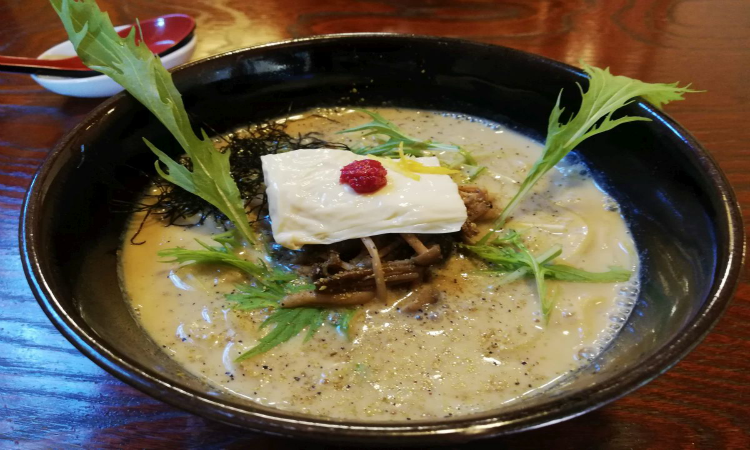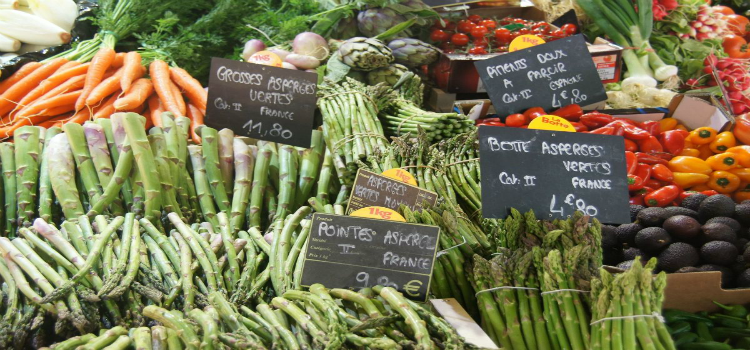Guest post by Wendy Werneth (The Nomadic Vegan) for Oliver’s Travels.
With the growing interest in veganism, you’ve probably noticed more and more vegan options popping up on restaurant menus and on grocery shelves. Whether you’re a life-long vegan or just trying it out for Veganuary, you definitely won’t be going hungry. It’s easier than ever to follow a vegan lifestyle at home, but what about when you’re travelling?
Well, vegan travel can be easy too! It might take a little extra planning and preparation, but you can absolutely travel anywhere you want to while following a vegan lifestyle. And you can have some delicious culinary experiences too! Here are my top 10 tips for making vegan travel easy and enjoyable.
1 – Download the HappyCow App
If you only do one thing to prepare for your trip, make it this: download the HappyCow app. HappyCow is a global directory of vegan, vegetarian and veg-friendly restaurants all over the world. It’s crowdsourced, which means that anyone can add a new listing, as well as reviews and photos.
HappyCow has actually been around for more than 20 years in the form of a website. But with the recent surge of interest in veganism, the number of listings has grown exponentially in the past few years. While the website is handy for doing pre-trip research, the app is a must-have once you’re on the ground.
At the click of a button, you can see all the vegan options closest to you, no matter where you are in the world. And in addition to restaurants, you’ll also find listings for health food shops, farmers’ markets, and vegan-friendly B&Bs.

Vegan Ramen discovered through HappyCow in Japan
2 – Research the Local Cuisine
If you’re headed to a more off-the-beaten-track destination, you may not find very many listings on HappyCow. But that doesn’t mean that there’s no vegan food where you’re going!
In this situation, the next step is to find out a bit about the local cuisine and identify some dishes that are already vegan or can easily be veganised by leaving out an ingredient or two.
That way, you won’t need to rely on finding speciality vegan eateries. Instead, you’ll be able to walk confidently into traditional, local restaurants and know what to order.
The first time I ever travelled as a vegan was on a three-week trip around Greece. I was a bit nervous about the whole prospect, but once I did a bit of research I realized that there were dozens of vegan dishes in Greek cuisine!
This is due in part to the Greek Orthodox fasting tradition. Many religious people in Greece “fast” for up to 180 days out of the year! This doesn’t mean that they eat nothing at all; it just means they avoid certain animal-based foods.
With just a couple of exceptions, Greeks eat a vegan diet when fasting. Interesting, huh? By learning about the local cuisine, you will also learn about the local culture in the place you’re visiting.
3 – Eat at Ethnic Restaurants
Usually, a cuisine will have at least a few naturally vegan dishes, and some will have dozens to choose from. But there are some destinations where the local cuisine is just not very vegan-friendly.
Take Switzerland, for example, where even the name of the country is synonymous with cheese. Or northern France, where most dishes are based on meat and dairy, and even vegetables are usually cooked in butter. If this is the case where you’re headed, you might want to steer clear of the traditional local restaurants.
Instead, seek out restaurants serving ethnic cuisines that you know are vegan-friendly. This isn’t hard to do, as virtually all of the world’s most popular cuisines (with the exception of French cuisine) include plenty of plant-based dishes.
At an Italian restaurant, for example, you’ll be able to get some tomato bruschetta and a veggie pizza or pasta dish without any problem. Or at a Chinese restaurant, you can ask to replace meat with tofu in any dish. Indian, Thai and Middle Eastern restaurants are also reliable options.
It might be useful to find out what kinds of ethnic restaurants are popular in the area you’re visiting. To continue with our northern France example, you’re sure to find a Moroccan restaurant in pretty much any town in France. So a vegetable couscous is never far away.
4 – Seek Local Advice
The best sources of advice about where to find vegan food are the local vegans living in your destination. One way of connecting with them is by joining local Facebook groups.
You can ask specific questions directly in the group, or just take a look at the recommendations in previous posts. As an example, if you were planning a trip to Cyprus, you would search on Facebook for “vegan Cyprus” and then click on the Groups tab to see relevant groups.
You’ll find that there are several active groups for vegans in Cyprus, including one run by the Cyprus Vegan Society with more than 3,600 members, and one devoted exclusively to sharing vegan products found in supermarkets. The latter would be extremely helpful if you were planning to prepare your own meals during your trip.
Another way of finding local recommendations is to search relevant hashtags on Instagram. The most obvious ones are hashtags with the word “vegan” plus the name of your destination, like #veganportugal or #veganlisbon.
In the vast majority of cases, you’ll find plenty of food photos from locals and other vegan travellers who have passed through the place you’ll be visiting. If your destination is really off the beaten track, then you might just need to widen your search a bit, for example by searching for #westafricanvegan instead of #burkinafasovegan.

Veggies in Toulouse market
5 – Make Special Requests
Just because you don’t see any obvious vegan options on a restaurant’s menu, that doesn’t mean that you won’t be able to get a tasty vegan meal there. This took me some time to wrap my head around when I first went vegan because I had always thought that my options were limited to what was written on the menu. Not true!
Don’t be afraid to ask restaurant staff to adapt a dish for you, or even to make something special that’s not listed on their menu at all. It will feel weird to you the first time you do this, but it probably won’t seem weird at all to your server.
Nowadays, people working in the food industry get special requests all the time from people with food allergies or other dietary requirements. In most cases, if you ask politely, they will be happy to help.
And if you’ll be staying at a hotel that serves breakfast, send them a quick note in advance to let them know you’re vegan and ask what they can offer. Most places will at least provide plant-based milk for cereal and coffee on request. I’ve even had some go out of their way to provide vegan yoghurt, vegan croissants and vegan Nutella!
6 – Book Accommodation with a Kitchen
One way to ensure that you get to eat the food you want is to cook it yourself. Booking an apartment, villa or another type of accommodation with access to a kitchen will allow you to prepare your own meals, so you’ll have no doubt about exactly what’s going into each dish.
Oliver’s Travels offers villas and holiday homes with modern kitchens that come with all the amenities needed to prepare a delicious meal.
Or better yet, get a private chef to prepare your food for you! If you request their holiday catering service, your own private chef will come to your holiday home and cook and serve each dish to you. Oliver’s Travels offer a wide range of menus with plenty of veggie options by default, and menus can always be adapted to be vegan on request.
7 – Pack Vegan Travel Snacks
It’s always a good idea to have an emergency stash of snacks on hand, just in case. I’d actually recommend this to anyone who’s travelling, vegan or not. You never know when you might get stuck in a traffic jam or have some other unforeseen delay!
Admittedly, as vegan options have increased over the years, I’ve become a bit slacker about packing my emergency food stash. But I do still throw a few granola bars or some trail mix into my bag if nothing else.
There’s no need to overdo it; remember that you’ll be able to restock during your trip if necessary. Healthy vegan snacks like nuts, dried fruit and energy bars are widely available pretty much everywhere. The idea is just to always have something on hand to eat so that if you end up at a place with limited vegan dining options you won’t worry about starving.

Dried fruit in a Russian market
8 – Choose a Vegan-Friendly Destination
If you follow the advice in the points above, you can go anywhere as a vegan. My personal approach to travel is to try to see as much of the world as possible, and that didn’t change when I became vegan.
Despite what I said earlier about Switzerland not being vegan-friendly, I lived there for more than two years as a vegan and got by just fine. With a bit of digging, I even uncovered some vegan Swiss speciality dishes.
However, if you are new to veganism and are nervous about this whole vegan travel idea, you might want to start with a destination that you know is going to be vegan-friendly. And there are plenty to choose from!
You have cities with strong vegan movements like Berlin in Germany, Chiang Mai in Thailand and Ubud in Bali. But then you also have plenty of countries whose traditional cuisine happens to include lots of plant-based dishes, even though veganism as a concept may not be widely known there.
Examples of the latter type of vegan-friendly destination include Italy, Greece and India. Authentic Italian cuisine is much more than just pizza and pasta and includes many plant-based dishes featuring fresh vegetables and legumes, especially in the south of the country. As explained above, Greece has many vegan dishes too, thanks largely to the fasting traditions in the Greek Orthodox Church.
And India has more vegetarians than any other country in the world. More than 30% of Indians follow a lacto-vegetarian diet, so finding a meal free of meat, fish and eggs is no problem at all. The only thing to watch out for there is dairy, which can be left out of most dishes on request.
Check out this guide for a list of the top 7 cities for vegans.

Pizza with vegan cheese in Italy
9 – Learn Some Key Words and Phrases
For many people, one of their biggest fears about travelling abroad is not being able to express themselves in a foreign language. It’s definitely a good idea to learn the words for meat, fish, dairy and eggs in the language spoken in your destination.
This can be more useful than learning to say “I am vegan”, since not everyone knows what “vegan” means. And if you’re not feeling confident enough in your language skills to express this on your own, bring along a phrasebook or app that will do it for you.
The best one around is probably the Vegan Passport produced by the Vegan Society in the UK. It explains in 79 different languages what vegans don’t eat, and also gives plenty of examples of what we do eat. Originally available only as a paperback phrasebook, you can now download it as an app to your smartphone.
10 – Join a Vegan Tour
Hopefully, after reading this you feel more confident about being able to fulfill all your travel dreams while following a vegan lifestyle. But if you’re intimidated by the idea of doing all the research yourself, or you just don’t have the time, there is another option.
A growing number of travel companies are now offering vegan tours in different locations all over the world, from Italy to India to Thailand. These include vegan-run companies that focus exclusively on vegan tourism, as well as mainstream companies that have recently started adding vegan foodie itineraries to their repertoire.
In addition, many other companies are happy to provide vegan meals for individual participants on request, although the quality of the food will probably not be as good as on a fully vegan tour. From vegan adventure holidays in Belize to luxury vegan cruises through the glaciers and fjords of Chile, you can find a full list of vegan tour options here.
 Wendy Werneth is an intrepid world traveller, vegan foodie and animal lover who has traveled in more than 100 countries. She is the author of the book Veggie Planet and the creator of the award-winning vegan travel blog The Nomadic Vegan, where she uncovers vegan treasures across the globe, even in the most unlikely places! You can follow her foodie adventures on Instagram.
Wendy Werneth is an intrepid world traveller, vegan foodie and animal lover who has traveled in more than 100 countries. She is the author of the book Veggie Planet and the creator of the award-winning vegan travel blog The Nomadic Vegan, where she uncovers vegan treasures across the globe, even in the most unlikely places! You can follow her foodie adventures on Instagram.
5 sustainable hacks for eco-warriors in 2020
Map of the most vegetarian-friendly cuntries


Hello Wendy,
You are absolutely correct. It’s easy to follow a vegan lifestyle at home, but it becomes quite difficult when we are travelling to some new places. Proper planning and prior research can help us a lot.
Thanks for sharing these wonderful tips. It’s very helpful to me as well as others who are new to a vegan lifestyle.
Keep sharing such valuable information.
Regards & Best Wishes to you!